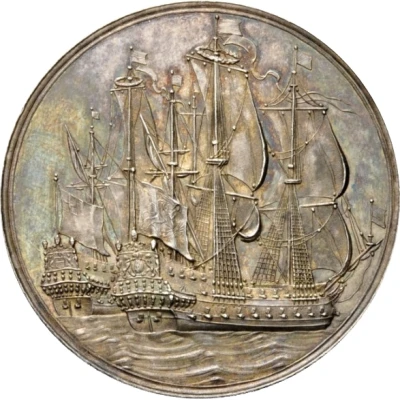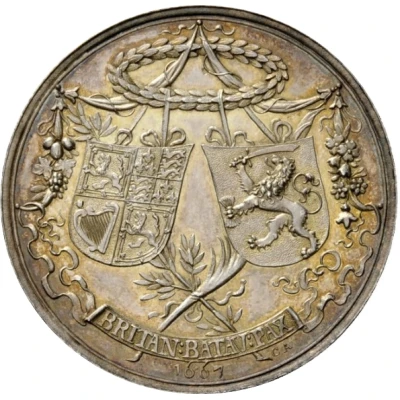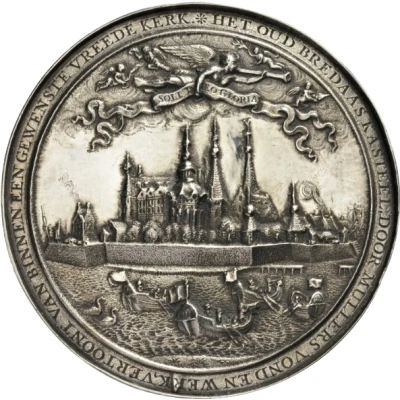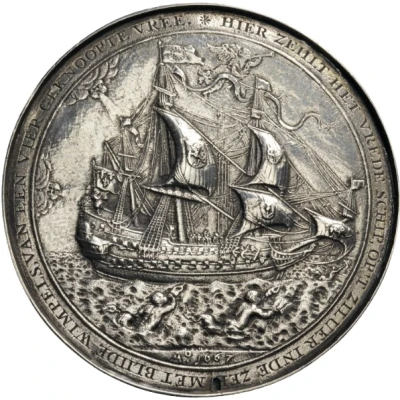
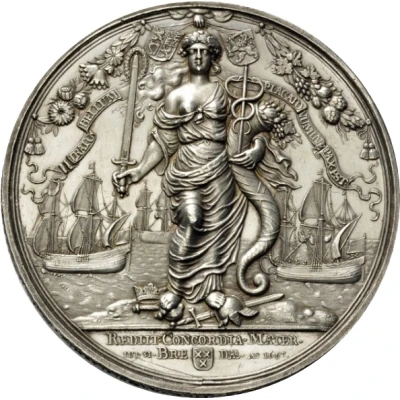

© Nomos AG
Medal - Peace of Breda
1667 year| Silver | 122.24 g | 71 mm |
| Location | Dutch Republic (Netherlands) |
|---|---|
| Type | Medals › Commemorative medals |
| Year | 1667 |
| Composition | Silver |
| Weight | 122.24 g |
| Diameter | 71 mm |
| Shape | Round |
| Technique | Milled |
| Orientation | Medal alignment ↑↑ |
| Demonetized | Yes |
| Updated | 2024-11-14 |
| Numista | N#187301 |
|---|---|
| Rarity index | 100% |
Reverse
Pax standing facing; above, hand of God emerging from the clouds holding the shields of England and the Netherlands, and, long ribbon
Script: Latin
Lettering:
IRATO BELLUM PLACATO NUMINE PAX EST
REDIIT.CONCORDIAE.MATER / BREDAE
IUL.31 .Ao.1667.
Translation:
war from an angry divinity, peace from one appeased
Mother Concord has returned at Breda
Engraver: Christoffel Adolfzoon
Edge
Plain with inscription.
Lettering: NUMISMA.POSTERITATI.SACRUM.BELGA.BRITANNOQUE RECONCILIATIS,CUM.PRIVIL:ORDIN:HOLLAND:ET:WEST
Translation: medal consecrated to posterity on the occasion of the Peace between the United Provinces and Great Britain. With the permission of the States of Holland and West Friesland
Comment
MI I, pp. 528-529, 176. Scher, The Proud Republic, 38. TMNK 00740. Van Loon II, pp. 534-536, FNM I. Milford Haven 585This is one of the most famous of all Dutch medals, but has the dubious distinction of while being struck in honor of the peace treaty that ended the Second Anglo-Dutch War (1665-1667), was actually one of the causes of a subsequent war! The reason for this is that the hag on whom Hollandia treads on the obverse has the epithet Mala Bestia, pernicious beast, which had been used for the English king Charles II by his enemies (and the features of the Hag are similar to those of Charles as well)! Not only that, but the Dutch destruction of the British fleet at Chatham (known as the Battle of Chatham in Dutch sources and the Raid on the Medway in British) appears as well. This remarkable feat, under the Dutch Lieutenant-Admiral Michiel de Ruyter, led to the Peace Treaty of Breda, which this medal commemorates. However, it was surely not the most diplomatic thing to put on a peace medal; Charles II’s government protested and, in the end, the medal was recalled and its dies destroyed (though the Dutch authorities had previously made sure that everyone who wanted an example, had one!).
